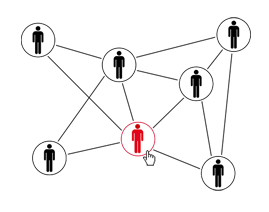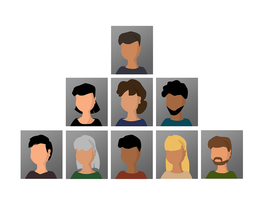The Neurodiverse An Untapped Pool of Exceptional Talent
Our understanding of the brain and how it works so magnificently, has increased exponentially over the last 10 to 15 years. Though the brain is still a mystery on many levels, our increasing understanding of how it functions is allowing scientists to map the brain down to the cellular, molecular and even quantum level, much as the DNA scientists did with the Human Genome Project, at the end of last century.
As a result, we understand many conditions, such as autism much better and increasingly recognize the unique capabilities and talents that people with “different brains” can bring. More and more companies are recognizing the power of “neurodiversity” in their workforce and are actively recruiting people on the autistic spectrum, as this pool of talent often successfully solve knotty challenges that the majority of people cannot do. Different brains can also be very successful in seeing things that other people don’t see, creating innovative products or services that people have never thought of.
Unfortunately, somewhere between 66% to 86% of adults who are on the autistic spectrum are unemployed or significantly underemployed (Rudy, 2019). While the exact number varies based on the research and survey parameters, there's little doubt that employment is not readily available for adults on the autistic spectrum. There is a long-held stigma around people with autism – they are often considered to be highly rigid and moody, possessing poor communication and social skills.
But when we go below the surface we learn that there is a much more intricate and nuanced reality from what we see on the exterior. Namely that this condition is not stand-alone but actually a broad spectrum of characteristics that are better described using the term “neuro-diversity”; those with autism, ADHD, and other learning or neural processing differences. Note the word “differences” because the more we understand the origin of these conditions, the more we learn that they are a normal part of human brain evolution.
Neuro-diversity is a term that’s been around since the 1990s, when it was first coined by the Australian sociologist Judy Singer (Singer, J. 1999). What Singer was looking to describe was a group of conditions such as ADHD, dyspraxia, dyscalcula and autism which aren’t “abnormal” or “diseases,” but simply variations of the human brain that are a natural part of the tapestry of human variety. The trick, and the opportunity, is to learn how to leverage neuro-diverse individuals’ unique talents to everyone’s benefit.
Neuro-diversity in the workplace is beginning to have a major impact on organizations. In just the past few years a number of the world’s top companies have put in place active and targeted programs to recruit neuro-diverse individuals. Why are they doing this, and what do they stand to gain? The advent of the information economy and the data-intensive nature of work in the 21st century workplace has opened up entirely new opportunities for meaningful engagement of individuals with innate talents uniquely well suited to detailed, quantitative, data-immersive employment.
The good news is there is an untapped pool of talent to fill these roles if we just think differently about what “normal” means in the context of who we hire. Many companies have learned how to tap into the thought patterns and work ethic that are common among neuro-diverse individuals. This is why companies such as German-based software giant SAP have had, for more than 3 years now, a program specifically recruiting people who have autism or related differences. SAP is, as they put it, tapping into a pool of talented people who can bring innovation and new ways of working that drive new notions and ideas for products and services that do not exist today (Phillips, 2019). Other companies that have joined SAP in putting in place similar programs with similar goals are:
• Microsoft
• Freddie Mac
• Ford Motor Company
• Ernst & Young
• Walgreens
Unfortunately, all too often, this pool of exceptional talent is left on the sidelines. I recently met a young man on the Autistic Spectrum, Oliver Fenghour, who told me his story of the challenges he has faced in finding employment that leverages his unique skills and capabilities:
I was diagnosed with Asperger’s Syndrome a high-functioning form of autism when I was 10. In hindsight when I look back at my diagnosis, I never really knew what being on the Autistic Spectrum would mean for me and my loved ones. For my parents I suspect many conflicting emotions were going through their minds. Would our son live a ‘normal life’ would he have all the opportunities of his peers, would he forge a successful career, get married etc.
Personally, my memories of being diagnosed at a young age, made me feel like I was inferior to my peers and contemporaries. Certainly, transitioning from primary school to secondary school was a culture shock which when I reflected upon in later life, I was totally unprepared for. School children at that time could be highly vindictive and nothing prepared me for an environment during my secondary school years which would prove to be such a chastening experience. I always felt that during my time at secondary school that teacher’s fell into two categories in what they did or did not know about the Autistic Spectrum. The first category would be teachers who simply put me into the prism of eccentric and idiosyncratic behavior that I would eventually grow out of. The second category of teachers had some limited understanding of the Autistic Spectrum but could not translate a limited abstract understanding into practical support within the classroom. In all honesty leaving school at 16 with little in the way of meaningful qualifications and no friends was a blessed relief as in many respects leaving the education system felt like a liberating experience.
Sadly, my story has similar analogous experiences for a fair percentage of children on the Autistic Spectrum. According to educational statistics published by the National Autistic Society only 34% of teachers have an adequate or reasonable understanding of how to support autistic children in the classroom. In 2018 the Supreme Court in a landmark case ruled that schools must offer reasonable adjustments to children on the Autistic Spectrum and that expelling them from school was not the answer to the problem.
When I left school at 16, I thought that the education system had largely failed me and my needs. Surely, the workplace would be more switched on to supporting those on the spectrum. Sadly, very much like my secondary school years, employers seemed to view autism and hidden disability as a burden that they didn’t want to be saddled with. Over the course of five years from 16-21 I was in and out of employment with little in the way of support from employers who didn’t understand or want to understand the many benefits that employing autistic people in the workplace can bring. For, me my story changed when I was 21 and went to work for J Sainsbury PLC. Sainsbury’s from day 1 identified my needs and the adjustments that I would need to be successful in the workplace. The next 10 years of my employment journey with Sainsbury’s helped build my self-confidence and self-worth with an employer who were patient and compassionate towards their employees. Sainsbury’s helped me build into the person that I am today, and I still have many fond memories of my employment with them.
Around 18 months ago I decided that the time was ripe to move onto pastures new and see more of what was out there for those such as myself on the Autistic Spectrum. When I joined Sainsburys it seemed apparent then that employers and society had little in the way of knowledge or understanding of those such as myself on the Autistic Spectrum. When I left Sainsbury’s, I thought that with the implementation of the Equality Act in 2010 and the strive to become a diverse and inclusive society that opportunities for those on the Autistic Spectrum with compassionate, patient employers would be more widespread. Yet, my experiences since leaving Sainsbury’s could not have been more markedly different with employers who seemed more focused on the bottom line, with limited understanding or patience to support and develop Autistic talent within the workplace. My own personal experiences are sadly very similar to many others on the Autistic Spectrum. Evidence compiled from the National Autistic Society suggests that only 32% of people on the spectrum are in some form of employment. Yet, in the UK an estimated 700,000 people have autism and globally this figure is some 70 million.
As a society we seem hardwired by this perception that being disabled must mean that you have a physical impediment. This has meant that many people with ‘invisible disabilities’ such as autism have been largely ignored or forgotten about by society. However, recently it was announced that people with ‘hidden disabilities’ such as autism can have the right to access blue badges, allowing them to park in disabled spaces in car parks. Yet, this is one small step on what continues to be a long and arduous journey for those on the Autistic Spectrum to gain recognition and acceptance of their differences in a society that is suspicious of difference and wary of change.
In the workplace, providing enough reasonable adjustments for autistic employees doesn’t just help those with autism it can also benefit those with other disabilities in your organisation. All organisations need to look at SAP’s autism workplace strategy as a blueprint model for successfully integrating autistic talent in the workplace. Increasingly, as we advance further into the 21st Century, healthy disruption, innovation, and diversification of ideas will increasingly decide which organisations are the right side of the dichotomy between success and failure. Therefore, looked through a pragmatic and shrewd prism, a concise and pliant reasonable adjustments structure is far more likely to succeed in an organisation than one which is fixed and rigid in abstract, and application.
Employing people with autism has many key benefits such as:
• Distinctive logical and analytical capabilities
• Sustained Concentration and perseverance even when tasks are repetitive
• Conscientious, loyalty, and sincerity
• An exceptional eye for details, deviations and potential errors
• A strong interest in factual matters and comprehensive technical expertise
Oliver’s story is a compelling one, but unfortunately, all too common. However, despite the challenges he has faced, he (and I) see change coming. I honestly believe that with the right support, guidance and training in place, autistic employees, and the neuro-diverse, can flourish within your organisation. You have a simple choice: look to employ neuro-diverse talent and continue your growth journey as an organisation or risk losing market share and ideas to companies more willing to be innovate. What will you choose?
You May Also Like

The CMO of People
Many organizations are not getting the best out of their HR function. Ask a CEO, “What is your...

The Challenges of Hiring Future Ready Leaders and Russian Doll Theory of Hiring
One of the biggest challenges most companies face today is hiring transformational leadership talent...

Why Do Most Innovation Programmes Fail?
What do companies do when a new boss says “Innovation has to be part of our DNA”? Here ...

The Greatest Resource any Organization has is the Creativeness of People
For too many years people have been treated as expense items instead of highly valuable resources. T...

How To Quit A Job You Love
It is not easy to quit a job you love. Even with a new dream job in-hand, cutting the cord that conn...

Take on Mistakes
Yes, we do say mistakes teach you a lot and you shouldn’t be afraid of making mistakes. But we...

Five Stages Of Organization Evolution And Key Characteristics And Concerns At Each Stage
Organizations almost always progress through five more-or-less well-defined evolutionary growth stag...

Managing in Multi-Cultural Environment
As several companies expands the business overseas, it is crucial to understand how to run the busin...

Crossing Corporate Cultures Creativity In Organizations Across Industries
Every market has its own unique business practices. People working in different business sectors dev...

Four pillars of Yoga for holistic health
Every human is unique; therefore it is necessary for each of us to find out for ourselves how we can...

Brave to Lead Like a Girl
All of us are dealt a unique deck of cards. Our aim is to identify our strengths and play those card...

How do you Extend Influence to Others and Change Lives?
You Change Lives When You Empower Others! (Extending Influence #1) When you empower others you chan...

How Important is Vision in a Successful Life?!
Understanding Vision (How Important is Vision #1) How do you communicate and give vision to ...

How do you Extend Influence to Others and Change Lives?
You Change Lives When You Empower Others! (Extending Influence #1) When you empower others y...

High Potentials vs High Performers
A Leaders Guide to Identify the Differences Mistaking a high-performing employee for...

Is 7% good enough?
A topic discussed at the recent World Economic Forum was the reluctance of male executives to mentor...

Learning & Development as Part of a (Digital) Transformation Strategy
The global workforce is constantly evolving to support a knowledge based, digital economy. Due to th...

The Future of Work – Digital Nomads and the Gig Economy
It is estimated that within a short couple of years, a large portion of the workforce (estimated to ...

Political Correctness towards Civility To be, or not to be, politically correct...
We can incidentally praise or criticize others depending on how we say it, the word choice or expres...

Let's not confuse loyalty with longevity
Let's not confuse loyalty with longevity It is interesting that the issue of loyalty in the wor...

The Attitude of Gratitude - Replying does not mean Answering
The Attitude of Gratitude - Replying does not mean Answering In the ever increasingly connected di...

(Work-Life) Balance or Harmony (! / ?)
(Work-Life) Balance or Harmony (! / ?) Welcome to the world of Work-Life Harmony, beyond Work-Life...

Making Board Meetings More Agile
Making Board Meetings More Agile Given my belief that the world we live in today has changed irreve...

It's Good To Fail
It's Good To Fail I want to share with you something different from a normal convocation speech...

Four Lifehacks To Be More Productive Now
Four Lifehacks To Be More Productive Now Here are four daily life-hacks to help you to be more pr...

A leader sets an example, a leader doesn’t just order things, he does it so that others can do it
A leader sets an example, a leader doesn’t just order things, he does it so that others can do...

How would you end Executive Loneliness?
How would you end Executive Loneliness? What is the hardest part about being a leader? Altho...

Leadership Soft Skills Required for Business and Personal Success
Leadership Soft Skills Required for Business and Personal Success We often get asked, “What s...

New-G Leaders: Remember the Cow
New-G Leaders: Remember the Cow "Cow Don't Drink Water, Cannot Push Cow Head Down"&nbs...

Google your self
What are your key leadership attributes? The beliefs and behaviours that make you unique and success...

Culture is not enough … Get the right culture
A few years ago in Europe I asked a group of business leaders if they had the right culture. S...

How Leaders Can Create a Culture of Agile Collaboration to Win in a VUCA World
China growth-deceleration, the normalisation of monetary policies on the USA, tepid economies in Eur...

Is LinkedIn Improving Itself Out of Business?
I still remember the day I joined LinkedIn. A friend of mine called in frustration and asked w...

Life is the Name. Transformation is the Game.
Over the past half a century, I come to realize life is about having gratitude and resilience. We ne...

How to handle negativity and negative colleagues at work
In arithmetic's, negative into negative equals positive. But that’s just in arithmetic'...

ADAPT or PERISH: It is time for HR professionals to decide and create a new function or move out of the way!
Artificial intelligence in recruitment and performance management giving employees their key deliver...

Leadership Confidence in Times of Uncertainty
How do you successfully lead an organization in uncertain challenging times? Unparalleled st...

Insights for Making Working at Home Work!
How can business and HR leaders manage challenges and find opportunities in the new realities of wor...

The Real You Is Not Really You…
The Real You Is Not Really You… We tend to see and act with our surrounding based o...

3 Powerful Lessons To Make A Successful Career Out Of Your Passion
It Feels Like a Dream As I went on stage today to receive the Asia's Most Talented Coaching Lea...

How to Recover Your Direction - a case study during COVID19
What really happened 5 days ago I set myself a new challenge. Coronavirus had fundamentally changed...

Career Tips, Please
Last week, I was tagged by the fab Tim McDonald in a LinkedIn post asking to share some pointers for...

Impact of AI on the workforce Pre and Post the Pandemic
With the sudden advent of COVID-19 - a global crisis of unprecedented scale, organisations now are c...

Career Kickstart
The first job you land could be the most important decision you make in your career. I have seen th...

Peter Principle - Are you a victim or Perpetrator?
The Peter Principle – Who do YOU Blame? In my junior years of business, many times clients an...

4 Best Practices CEOs and Public Speakers Can Learn from Athletes
What struggles do CEOs and public speakers have in common with athletes? For one, there’s the...

Who do you want to be in COVID-19?
Whilst reviewing friend’s pages on Facebook, previous colleagues, mentors and my business netw...

TRUST – The core enabler that influences and inspires your team
These are certainly extraordinary times for leaders. What do employees need from leaders? In...

On Mentoring
I attended a conference some years back. At one point when the speaker asked, “How many of us...

Men of Faith
Mankind is meant to create, both with their body and mind because that creates balance within. It ke...

What Being on TED Taught Me About Comfort Zones
“In order to grow, you’ll need to step outside your comfort zone.” We’ve al...

3 Tips for Setting and Achieving Goals
Last week I wrote about when setting goals for 2021 we should Go Big or Go Home because it...

Never ask employees what would make them happy at work. Do this instead...
Most managers have realized by now that happy workplaces are more productive, more creative, attract...

How to Choose the Right HRMS Product/Platform
The size of the business has become irreverent when it comes to the technology embracing, to remain ...

So, #IWD is done - where to next?
This week saw a record number of events to mark International Women's Day by organisations - bot...

The trauma of being “made redundant”
At work, there’s nothing quite as horrifying as the experience of being “made redundant&...

My Hopes and Dreams for Malaysia in 2021
Let’s face it – 2020 was not what we envisioned it to be. Since the start of last year, ...

What could post COVID mean for organizations?
This article was co-authored by Dave Ulrich. During this time of limited human interaction, we...

The foolproof way to get a new team to start collaborating, quicker – even in hybrid work environments!
The >#wfh environment does not give us enough organic opportunities to break the ice with ...

Why Do I Keep Hiring the Wrong People?
According to Hudson Singapore, 37% of employers are expecting to increase headcount in the first hal...

Being a Business Woman was Never My Plan
I never wanted my own business. It was never in my plans. Sure, I have an MBA. And, yes I have a fam...

The great resignation or attraction! Is this about work-life balance....or work life purpose?
In recent weeks, there have been many studies by McKinsey, Microsoft and others published that indic...

Tune in to your self to stay tuned to work
I began writing an article on LinkedIn in early 2018 with the same title and saved it as a draft. Th...

Self-Leadership - The Critical Success Factor
What is the critical factor for any organization, large or small, to achieve success? Is it a clear...

Appreciation at Workplace
One of my early memories of my first job after graduating is that working life was terrible. Why did...

The 6 'HABITS' of highly successful “Assistants”
No matter what your title, it is most definitely how you think, what you say and your behaviour that...

AI Thinking I We are Heading Towards Self-Awareness Machine (AGI)
AI Thinking I We are Heading Towards Self-Awareness Machine (AGI) Neuralink It is a neurotechnolog...

Are Capitalism and Democracy Compatible?
Are Capitalism and Democracy Compatible? America prides itself on being able to run two great syste...

Everyone's a Great Writer Now! So Why Does Reading Feel So Empty?
Everyone's a Great Writer Now! So Why Does Reading Feel So Empty? AI can make anyone sound like...








Tim Ringo
Board Advisor | Non-Exec Director | Author | Keynote Speaker |
Tim is an award-winning author, keynote speaker and board advisor on topics related to HR and Human Capital. His latest book is Solving the Productivity Puzzle, published August 2020, on Kogan Page. Former Sr Exec at Accenture, IBM and SAP. Listed in "HR Most Influential Thinkers" - HR Magazine 2022. Awarded “Most Outstanding HR Consultant & Conference Speaker 2021 – UK” from Corporate Vision Magazine, and his book Solving the Productivity Puzzle won 2021 Business Book of the Year - HR and Management category. Most recently he was Vice President in SAP SuccessFactors Cloud HR Line of Business - Europe, Middle East and Africa. He led SuccessFactors' HR Advisory teams across the region. Tim is a Chartered Fellow of the CIPD (FCIPD) Previously, he was Vice President & Global Leader of IBM's Human Capital Management Practice, and before his IBM role, was Managing Director, in Accenture's Talent and Organization, Service Line. Tim began his career in Andersen Consulting (now Accenture) in 1990. In 2006, he was recruited to IBM Global Business Services where he led IBM’s global Human Capital Management (HCM) consulting practice, based in the UK. He led a team of more than 1500 Human Capital consulting professionals around the world.